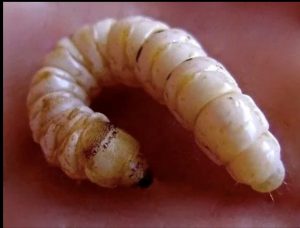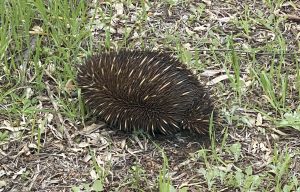Roasted Bardi is crispy on the outside and soft on the inside
BARDI (Witjuti Grub)
 Bardi, a moth larvae, were a staple of the Noongar diet and is rich in protein and abundant in the roots of Balga (Grass Tree) as well as Acacia wattle.
Bardi, a moth larvae, were a staple of the Noongar diet and is rich in protein and abundant in the roots of Balga (Grass Tree) as well as Acacia wattle.
Bardi were harvested throughout the year based on their larval cycles.
Noongar people located them by identifying signs like decaying Balga trees or small holes in the ground at the base.
Bardi were eaten raw or lightly roasted in hot ashes, making the outside crispy while keeping the inside soft and creamy.
The decline in the number of Balga trees due to land clearing and changes in fire management practices has impacted the availability of this important food source.
NYINGARN (Echidna)
 Nyingarn are an egg-laying mammal and were a favoured Noongar food source. Their fatty meat, often compared to pork, was roasted whole in hot ashes, causing the spikes to fall out as they cooked.
Nyingarn are an egg-laying mammal and were a favoured Noongar food source. Their fatty meat, often compared to pork, was roasted whole in hot ashes, causing the spikes to fall out as they cooked.
Nyingarn held cultural significance, as their behaviour was interpreted as a sign of environmental changes..
For instance, unusual digging activity could warn of shifting weather patterns.
Today, habitat destruction has contributed to a decline in nyingarn populations, affecting both their numbers and their cultural significance.
DJUBAK (Bush Potato)
These tubers, from a Leek Orchid, were dug up and formed a nutritious food source and significant part of the diet.
Yorga (women) would dig up the tubers using wanna (digging sticks), tools made from wood or bone.
Careful digging was required to avoid damaging them and broken tubers would be replanted to ensure sustainability for the following year’s harvest.
They could be eaten raw or baked in the coals.
The disruption of native flora from historical land use and grazing practices has reduced the availability of djubak.
DJIRAP (Kangaroo Grass)
DJIRAP seeds, along with other kwolak (grains) like edible acacia seed, were staple foods for Noongar families.
Harvested during the warmer seasons of Birak and Bunuru, the seeds were dried and ground with a muller (traditional grinding stone) to create fine flour.
This flour was mixed with kep (fresh water) to make dough, which was then cooked over hot coals to produce damper, a traditional flatbread.
Dried seeds were also stored at karlerl (family camps) for later use, ensuring a reliable food supply throughout the year.
The reduction of native grasslands due to historical agricultural expansion and invasive species has diminished the availability of djirap, threatening this once important food tradition.
A number of ‘bushfoods’ cultural information signs can be viewed at Noongar Trail location 10 (along the river’s edge in Lloyd’s Reserve).
A huge thanks to Bendigo Bank, Chalice, Dudja Dreaming, CBH Group, AYMS, and Lions Club for their support.
If you or your business would like to provide support to help us complete the Trail, please contact our volunteer Trail coordinator, Helen Shanks, at noongarkaartdijin@gmail.com.
